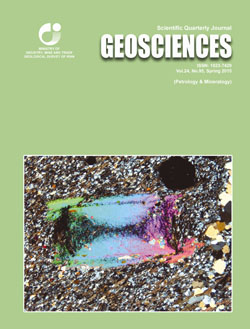Document Type : Original Research Paper
Authors
1 Ph.D. Studetnt, Department of Geology, Faculty of Earth Science, Shahid Beheshti University, Tehran, Iran
2 Professor, Faculty of Earth Science, Shahid Chamran University, Ahvaz, Iran
3 Ph.D. Studetnt, Faculty of Earth Science, Khorram-Abad University, Khorram-Abad, Iran
4 M. Sc., Faculty of Earth Science, Shahid Chamran University, Ahvaz, Iran
5 Associate Professor, Faculty of Earth Science, Shahid Chamran University, Ahvaz, Iran
6 Assistant Professor, Faculty of Earth Science, Shahid Chamran University, Ahvaz, Iran
Abstract
The Aligudarz region is located in middle part of the Sanandaj-Sirjan Zone. During and before the Jurassic time, a variety of Cu, Fe, Zn-Pb and Ba mineralization are formed in this area due to tectono-magmatic activities. This diversity of mineralizations with volcano-plutonic activities caused some complexities and ambiguities in geology-metallogeny evolution of the region. In this way, the aim of this study was investigation of geological evolution and its relation with mineralization and tectono-magmatic evolution of the Aligudarz region. The field and petrographic observations show that mineralization composition consist of barite with sulfide minerals (chalcopyrite, pyrite and covellite) and Fe-oxides in the Farsesh deposit withPermian carbonate host rock in the Farsesh area; sphalerite, galena and chalcopyrite in the Jurassic phylite, slate and meta-sandstone host rocks (Gol-e Zard deposit) and Cu mineralization associated with andesite rocks. In order to approach these aims, sampling for petrographical and geochemical studies with ICP-MS was done from each ore body separately. In addition, the granitoid rocks of the region were considered. In the Gol-e Zard Zn-Pb deposit, REE pattern represent enrichment of LREEs and La/Lu>1. The metamorphic host-rocks show positive Ce and negative Eu anomalies, whereas sphalerite, galena, chalcopyrite and quartz show negative Eu and Ce anomalies. Lack of Eu anomalies indicates high Oxygen fugacity during the precipitation of these minerals. Therefore, according to similarity of REE pattern in host-rock and ores of the Gol-e Zard deposit, it seems REEs extracted from host rock and then added to mineralizing fluid. The chondrite normalized pattern of REEs in barite ores and its host rocks in the Farsesh deposit show LREE enrichment. The positive Eu and negative Ce anomalies indicate that hydrothermal fluids are the main fluids, which caused precipitation of barite inthe host rock. REE pattern of andesite rocks show the same magmatic source for these rocks. LREE enrichment in andesite samples, lack of Eu and Ce anomalies indicate that clinopyroxene and plagioclase were crystallized in the same time and Ce+3 extracted with other REEs from depositional environment. The chondrite normalized pattern of granite rocks in the region show LREE enrichment, negative Eu anomaly and lack of Ce anomaly, which can indicate that diffraction process was controlled by plagioclase crystallization during the granitoid generation. The chondrite normalized spider diagram show the same trend of depletion of HFSE and HRRE and enrichment of LREE and LILE for all of the samples, which represent occurrence of magmatism in the study area and indicate all of these mineralizations are related to the subduction zone. These studies indicate that there is geodynamically a genetic relation between mineralizing fluids and volcano-plutonic activities of the region during or before the Jurassic system.
Keywords

